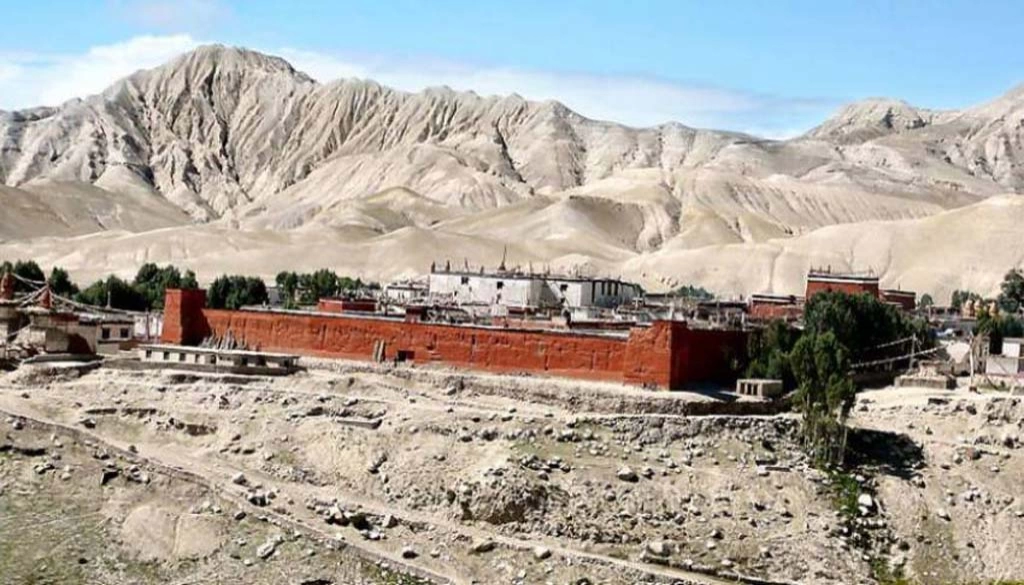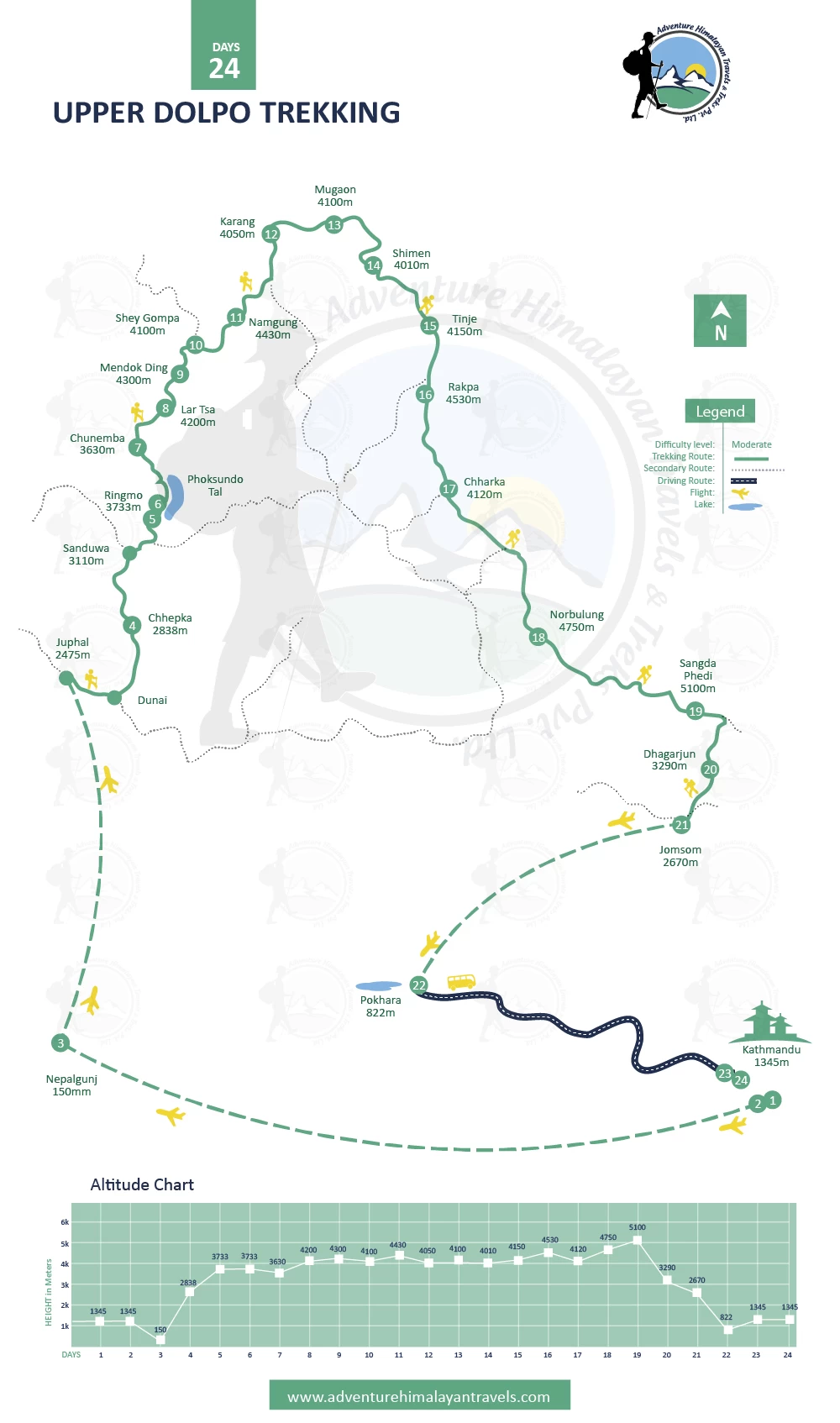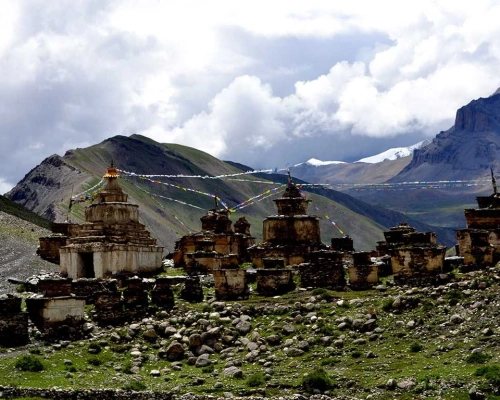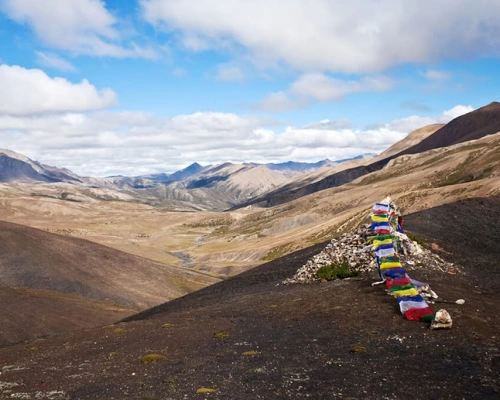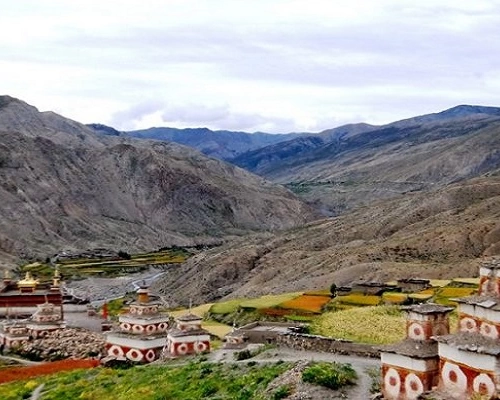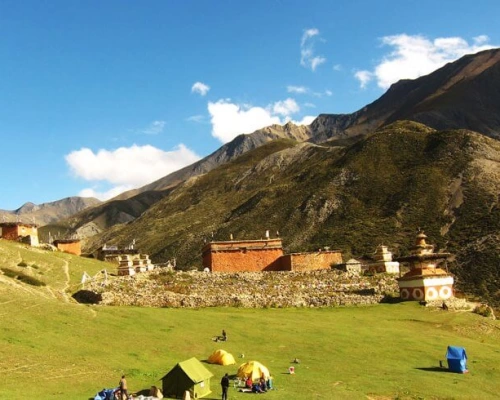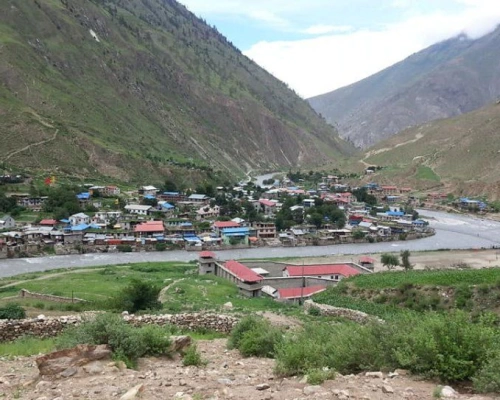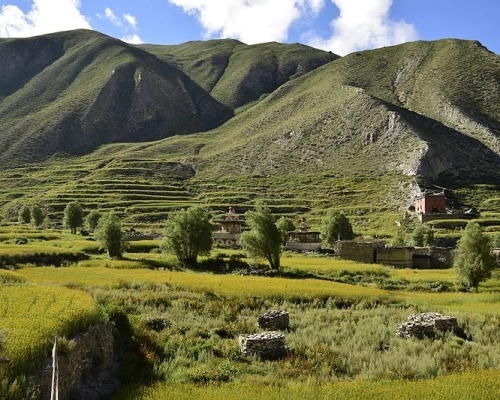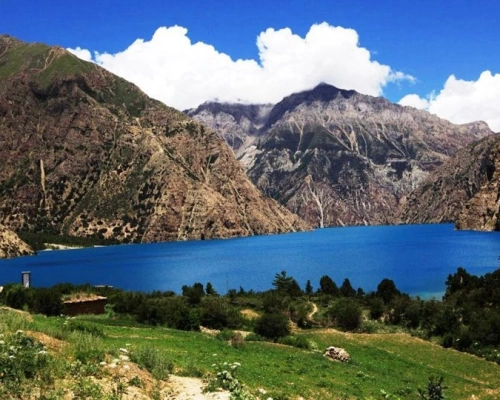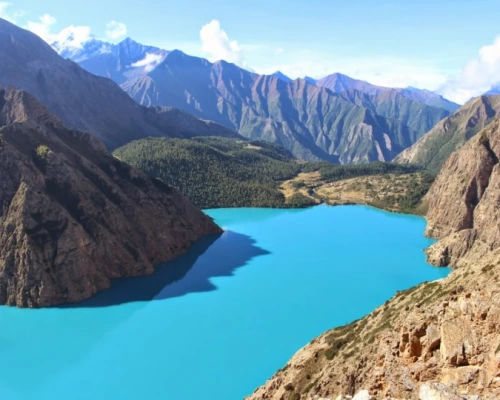Inner Dolpo has a magical, mythical appeal. The landscapes here are even more desolate than on the Dolpa Circuit and the villages even more isolated and pure. In Inner Dolpo century old Buddhist traditions, interwoven with shamanistic influences, are still an important part of daily life. The villages, gompa’s and people you meet during this trek will leave an unforgettable impression on you.
Inner Dolpo is a restricted area, for which a fee is charged of US$ 500 for the first 10 days, and US$ 50 for each additional day. Besides, there is a maximum of the number of foreigners that can enter Inner Dolpo each year. Currently this maximum is put at 250 people. This makes Inner Dolpo a very special and exclusive place.
The trekking brings you to Shey Gompa, which is often referred to as the spiritual heart of Inner Dolpo. It’s a magical place, situated at the base of Crystal Mountain, which is visited by hundreds of pilgrims each year. They make a kora (circuit) of the Crystal Mountain, Dolpo’s own version of Mount Kailas. The trek is an extension of the Dolpa Circuit, done in the other direction.
It is a very strenuous hike. You have to cross three passes, Kang La/ Ngadra La of 5350 m, the Shey La of 5000 m and Jeng La of 5110 m. These crossings involve long climbs and long descends. Besides, you stay above 4000 meters for a long time, with very cold nights. But the unforgettable landscapes, the views from the passes and the contacts with an untouched culture make it all worth it.
Leaving from Kathmandu, it’s a 20 days trip, but it can be extended as well, depending on the length of your walking days.
There are guesthouses in Juphal, Dunai, Kageni, Chhepka, close to Sanduwa (next to the Amchi Hospital), Ringmo, Shey, Saldang, Dho and Lingdo. At the other places you have to camp.
Walking times are of course a guideline and differ from person to person. The times mentioned, are excluding breaks.
Inner Upper Dolpo Trekking-24 Days
- Duration 24 Days
- Trip Grade Moderate
- Starts/Ends Kathmandu to Kathmandu
- Group Size 2-10
- Max. Altitude 5375 M.
- Best Season March, April, May and September, October
Itinerary
Upon your arrival at the Tribhuvan International Airport in Kathmandu, the Adventure Himalayan representatives will pick you up and transfer you to the hotel. After refreshment, you will be briefed in short about your tour by our guide or tour leader. If you have any questions or doubts about your trip then they should be asked and clarified at this time. Overnight stay at hotel.
Kathmandu Valley includes several UNESCO World Heritage Sites, including Pashupatinath (famous Hindu temple and cremation ground) Boudhanath (massive Buddhist stupa). We can also visit Swyambhunath, also known as Monkey Temple, which was built roughly 2000 years ago. Finally, we can visit Patan, city of fine arts. In the afternoon, you will be meeting with your trekking guide and will check all the necessary things. Overnight stay at the hotel.
To get to Dolpa, you have to fly to Nepalgunj first. Nepalgunj is a city in South Western Nepal, in the lowlands of Terai, close to the Indian border. You pass the busy of the bazaar and see horse carts full with people going to or coming from the Indian border. Overnight in hotel in Nepalgunj.
In the morning, we take a spectacular 35 minute flight over steep mountain ridges to Juphal. Juphal airport is just a gravel airstrip amidst the mountains and Juphal a small, mostly Hindu village. From Juphal you walk down over a small path among fields with wheat and vegetables to the Thuli Bheri River. Soon, we see a big iron suspension bridge, the Dhim Bridge of 99 m long. This is the entrance to the Shey Phoksundo National Park (SPNP). SPNP is Nepal’s largest National Park, established in 1984, with an area of 3,555 km⊃2. It aims to conserve the Trans-Himalayan ecosystem and the Tibetan type of flora and fauna. In 1998, and area of 1,349 km2. You have to pay 1000 rps entrance fee (except persons from SAARC countries, who pay 100 rps). We walk along the quiet path for several hours through forests and along emerald green rivers. More or less an hour after Shyanta, you reach Chhepka, a small village, surrounded by fields of barley. Overnight in Chhepka.
The path goes entirely through the forest today. Most of it is Nepali flat: sometimes going up and sometimes going down, with a couple of steeper climbs and descends, following the river all the time. It’s about 3 ½ - 4 hours walking to Rechi. The village Rechi is at the other side of the river. It’s a very small village and consists of just a couple of houses and a primary school. You can put up your tent here as well, if you want to call it a day. Otherwise, we continue on to Sanduwa, where we camp for the night.
It’s a short hike today to Ringmo and the Phoksundo Lake. After about an hour or two of trekking, we reach a viewpoint, where we will see a Nepal's highest waterfall of 167 meters high, the Suligad Waterfall (also called Phoksundo Waterfall). A nice place for a little break. 5 minutes after the viewpoint you will reach the top, and you will have your first view of the view of the Phoksundo Lake. It’s now half an hour more Nepali flat, walking through the forests, till you reach Ringmo. Overnight in Ringmo.
As the Phoksundo Lake is such a beautiful place, a free day here is recommended. Ringmo is a charming village that lies on the shore of Phoksundo Lake. People practice the Bonpo religion here. At the other shore, there is a beautiful Bonpo Monastery which you can visit. It’s a 20 minute walk to the monastery through the pine forest. In the monastery you can observe a statue of Thönpa Chenrab, the founder of Bonpo religion, a Buddha who lived thousands of years ago.
The trail contours along a rocky ledge. Climb to a crest at 4060m for spectacular views of Sonam Kang. The trail make steep and dusty descent through birches and blue pines.
After a nice break, we resume our journey towards Chunemba. The trekking route is about 5 hours long in total. We can enjoy the beautiful scenic beauty throughout the way while passing through the trail. Overnight in Chunemba.
The Phoksundo Valley gets quite narrow, with high rock walls on both sides. You have to cross a couple of streams. After about half an hour, you leave the main valley and enter a narrow gorge. The campsite is at Snowfields Camp, a name given by Peter Mathiesson in his famous book the Snow Leopard. It’s at the foot of the pass that will bring you in the heart of Inner Dolpo tomorrow. Overnight at Snowfields Camp.
It’s a long and strenuous climb of about 2½ hours over a dusty path to Kang La (5350m), locally called Ngadra La. Prayer flags and cairns mark the pass. The descent is pretty steep the first 45 minutes, but after this, it is going gradually for about 3 hours, till you reach Shey Gompa. Shey Gompa is a very small village. The 11th century gompa is located beneath the Crystal Peak on a small grassy plain, at the confluence of two rivers. It is said to be constructed by a Tibetan Buddhist, who arrived here on the back of a flying snowlion. It’s a magical place, and Shey Gompa is often called the spiritual heart of Dolpa. Every year hundreds of pilgrims come to visit the gompa and to make a kora (clockwise circuit) of the Crystal Peak. Overnight at Shey Gompa.
Today, you can go to Tsakang Gompa (4575m), a monastery from the Buddhist Kagyupa sect. This gompa appears in the movie Himalaya. The trail to Tsakang Gompa partly follows the same trail as pilgrims follow to make a kora of the Crystal Peak. Many bluesheep live here, as the abbot of Shey Gompa imposed a ban on hunting them. Also, in these regions you have the best chance of seeing the snow leopard.
Another pass to cross today, the Shey La, also called Gelu La, of 5000m. The climb to the pass goes through a narrow valley. From the pass we have a good view to the north of the arid Tibetan Plateau. After the pass, it’s a long descent through the pastures of Namgung. Scattered in the landscape, you will see some fields. Many times accompanied with a big Tibetan tent, as the fields are too far from the village to go there and go back each day. The people in Namgung are very friendly and open. Overnight here.
It’s a short hiking day today. The path goes high above the Namgung Khola (River) and then descends steeply to the village of Saldang. Saldang is the largest settlement of Inner-Dolpo. It is close to the Tibetan border where some of the salt trade caravans pass through. The people from Saldang are semi-nomadic. In the warm months they trek in the highlands with their herds of yaks and sheep. The ones who are better off let the pure nomadic people of Dolpa, the Drok-pa, do this work. Sometimes you can see a camp of the Drok-pa in these areas. Overnight in Saldang.
It’s a fairly easy walk to Sibu, following the Namgung Khola southwards and passing little villages along the way. The villages are surrounded by terraced fields of barley. The path goes alongside many mani walls, chörtens and some gompa’s, which makes you realize how important Buddhism is for the people of Inner Dolpo. Buddhism is interwoven in each and every aspect of people’s life here. Overnight in Sibu.
The trail starts with an easy stretch, following the river. The last village you pass is Raka. After this, you enter a large, inhabited valley. Look out for bluesheep here. After 2 hours of trekking, the path turns away from the river and climbs steeply to a meadow of about 4570m, which is often used by yaks to graze. This is Lagmo Che, the base camp for climbing to the Jeng La. Overnight in Lagmo Che.
It’s a steep climb of about 2 hours to reach the next pass: Jeng La (5110m). From the pass we have a spectacular view to the Dhaulagiri (8167m). After the pass you descend into the Tarap Valley. You arrive at the village Tokyu (4209m), a spread out village, which is the first human settlement after Raka. Tokyu is said to be the highest permanent settlement in the world. The gompa is worth a visit. It has a beautiful statue of Maitreya, the Future Buddha. Overnight in Tokyu.
Our destination is not far to Dho Tarap. At the entrance to Dho, we pass nice a gate chörten. Also the people of Dho are direct descendents of Tibetans. Dho Tarap is a traditional agricultural village, surrounded by fields. As in the other villages you came across, barley, buckwheat and potatoes are among the few crops that can grow here. But nowadays, small greenhouses enable the people to grow some green vegetables as well. The people in Dho are very friendly. A Tashi Delek (good day, like the Nepali Namasté), is always welcomed with a big smile. Close to Dho are 2 monasteries which are worth a visit. Ribo Bhumpa Gompa, right on the hill behind Dho, and Shipchaur Gompa, which is in the village Shipchok, 30 minutes walking from Dho. Overnight in Dho.
A short day today again, so that you have all the time to explore Dho in the morning.
Leaving Dho Tarap, you come along many mani walls and small chörtens. The path is going down, following the Tarap Khola. Gradually you can see the landscape changing. Some bushes are appearing, it’s getting a bit greener. Just before arriving at Sisaul, you have to climb to a small pass. After the pass, the valley gets suddenly narrow. It’s a short descend to Sisaul, which has a good campsite next to a tent-hotel. You can choose to camp here, or on one of the spots a bit further down.
Today, we mostly walk in the river valley with high rocks towering above you on both sides. The landscape is still pretty barren and this is your last change to see the bluesheep or snow leopard. It’s a fairly easy walk of about 3 to 3½ hours from Sisaul to Nawarpani. The path gradually goes down, with some parts going up as well. At some parts the path is beautifully carved out of the rock, so that you are walking in a kind of three sided tunnel. After Nawarpani, it’s a fairly easy walk over a pretty large path. In Laina Odar there is another tent-hotel, located at the riverside. This is a good place to camp.
From Laina Odar the trail goes down pretty steep to Laisicap (2772m). Although the trail is generally in good condition, there are a couple of landslide areas where the trail gets very narrow, and passing is a bit difficult. The path goes partly through forests and you are surrounded by steep cliffs full of pine trees. At Laisicap you have reached the river again, which is called Thuli Bheri river now. There is a police checkpost at the other side of the bridge and you have to register and show your permit. If you are lucky, you can see groups of large grey monkeys near here. Behind you, you can see the beautiful snowcapped Kang Tokal (6294m).Getting closer to Lingdo, you can see some other villages in the distance, like Sarakot, which is situated high on a cliff. These are the first villages you see after Dho Tarap. Lingdo is a small village with one guesthouse with a campsite. Plus a checkpost, so have your permit at hand again.
It’s an easy walk today. The first part goes through rough landscape. The path is sometimes carved out of the rocks, and at a few points very narrow.
After 2 ½ hours your reach the small village of Byasgar (2427m). After Byasgar, the trail goes through a greener landscape again. At the horizon you see the snowcapped Kang Tokal (6294m). Dunai is the headquarters of Dolpa District. It’s a large village, of about 2,500 people, more or less half Hindu and half Buddhist. Up the hill, there is a Buddhist monastery, which is worth a visit.
It’s an short walk to Juphal. After 45 minutes you reach a beautiful gate chörten (stupa), which is the entrance to the VDC (Village Development Committee) Dunai. You pass the big iron suspension bridge, which you crossed on the first day to get into the Shey Phoksundo National Park. It ’s about 2½ - 3 hours to Juphal from the bridge. Juphal is a large village with a small bazaar where it is nice to look around. Overnight in Juphal.
Early in the morning you fly to Nepalgunj. Especially the first part of the flight through the mountain valleys is spectacular. Later in the day, you fly back to Kathmandu.
We will transport you to the airport. Thanks for trekking with Adventure Himalayan travels. We look forward to seeing you again!
This itinerary is not suited for you? Plan your own trip.
What's Included
- 19 nights and 20 days of food and accommodation during trek (tent or local lodge)
- Kathmandu - Nepalgunj - Juphal and Juphal - Nepalgunj - Kathmandu airfare
- English speaking local expert guide, (porters,cook,sherpa and helper)
- Upper Dolpo permit fees ($500 for 10 days, $50/day after 10 days) and Lower Dolpo permit fees ($10 per week)
- Trekkers’ Information Management System (TIMS) fees
- Three nights’ accommodation at three star hotel in Kathmandu on twin sharing with breakfast, and one night in Nepalgunj with bed and breakfast
- Airport transfers and escort
- Farewell dinner in Kathmandu
- Equipment clothing for porter & staffs
- Equipment (sleeping bag, first aid kit, oximeter etc.)
- Camping equipment (tent, kitchen equipent, mattress, etc.)
- Insurance for all staff & porters.
- Trekking achievement certificate
- Adventure Himalayan Tshirt
- Nepal visa - Multiple Entrée 30 days - USD 50 (Details in Visa Page)
- International flight
- Lunch & dinner during hotel stay in Kathmandu
- Hot shower and electronic charging fees at guest houses during the trek
- Alcoholic drinks, candies, etc.
- Extra accomodation and meals outside of itinerary
- Personal gears & clothing (available on hire)
- Tips, any expenses incurred in emergency evacuation/road block due to any reason, table drinks, snacks while walking.
Dates and Prices
| Date | Price | Availability | ||
|---|---|---|---|---|
| Start DateStarts: MondayDec 29, 2025 | End DateEnds: WednesdayJan 21, 2026 | PricePriceUS$3595 | StatusStatusAvailable |
